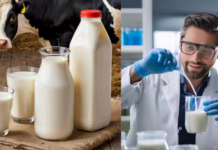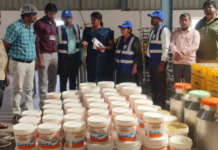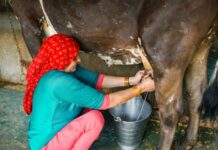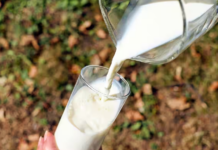The row over beef, vigilante groups, police high-handedness and the central government order on cattle trade have had a ripple effect on the 75-year-old market in the Ganesh Talkies area of Kolkata.
New Delhi, June 05, 2017: As the West Bengal government locks horns with the Centre over its notification banning the trade of cattle at animal markets for slaughter and meat, there has been one fallout: supply to the largest fresh milk market in the country has halved and there has been a sharp rise in prices. Traders say it has become very difficult to bring cows and buffaloes from Uttar Pradesh and this has hit the milk market very hard. The row over beef, vigilante groups, police high-handedness and the central government order on cattle trade have had a ripple effect on the 75-year-old market in the Ganesh Talkies area of Kolkata.
The market comprises over 150 traders, dealers and retailers who deal daily in over 1.5 lakh litres of milk. During the festive season, milk supply rises to around 3 lakh litres per day. Ever since the row, this daily supply has dipped to 55,000 litres of milk. “People are scared to bring their cattle to the markets in UP. It is difficult to lead the cattle out of the market after buying them. It is almost impossible to transport them. Vigilante groups to police, all are snatching away the cattle. It makes no difference to them whether the cattle has been bought for slaughter or for milk. Our main cattle markets are located in UP including Dildarnagar which has been shut for the past two months,” Rajesh Sinha, president of Jorasanko Dughdo Byabshayi Samity, said.
“Ours is the largest fresh milk market in the country. The problem of procuring animals for milk started over a year ago, but the situation has deteriorated in the last few months. Earlier, on an average, over 1.5 lakh litres of milk used to be supplied to and from the market. Now it is half. The price used to be Rs 50-55 per litre. It has jumped to Rs 70-80 per litre,” Sinha said.
The traders, many of whom own goshalas, buy lactating cows and buffaloes from UP and bring them to West Bengal via Bihar and Jharkhand. The cows are placed in goshalas in areas surrounding Kolkata including the districts of Howrah, North and South 24 Parganas. After seven-eight months (four-five months for low quality animals), the animals stop giving milk and are sold to middlemen who sell it to villagers. The middlemen sell some animals to slaughter houses, and smuggle still others to Bangladesh. The cattle end up with the middlemen because goshalas find it difficult to make mating arrangements. Fresh animals are brought in every month to maintain milk production.
With the rise of cow vigilante groups, especially in UP, Bihar and Jharkhand, the number of animals entering West Bengal, even for milk, has declined. “For the past one year, we have been facing such problems. After the new notification, it has become very difficult We buy cattle two-three times from cattle markets in UP to maintain our stock of fresh animals. But the UP markets are shut. Some trucks carrying cattle are stopped by different organisations and police in UP, Jharkhand and Bihar,” said Sanwar Ali, owner of dairy farm Haji Zahoor Ahmed and Sons, which has been in the milk business since 1951.
“Now milk production is falling in our goshalas. Earlier, 3,000 litres per day used to come from my farm. Now, it is only 1,000 litres. I have labourers to pay. If I lose my income, how will I pay my labourers. The future looks bleak,” he said.
The Indian Express

































